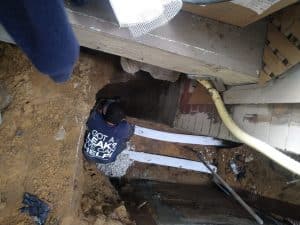The issue of our times is a changing climate, and the impact that has on all of our lives. As the air becomes warmer, and temperatures rise up, that means a more intense water cycle, with more moisture evaporating into the atmosphere.
That leads to changes in rainfall patterns, and more storms. Downpours are more intense. There is more snow, which melts more rapidly.
With an increase in precipitation comes an increased risk of flooding. If you own or rent a house, with a basement, you know what we are talking about.
The home’s foundation drainage system is interconnected and complicated, and includes the city’s sanitary sewer lateral, perhaps a storm service lateral (in newer homes), a weeping tile system that channels water away from the foundation, drain pipes and sump pumps. Any failure there leaves the home exposed to flooding.
BASEMENT FLOODED HOME REPAIR COSTS THAT CAN TOTAL THOUSANDS
For most people, purchasing a home will be the most significant investment they make in their lives.
How many of us though have directly experienced, or heard horror stories, about walking down the basement stairs to find a foot or two of water, or a cascade of water pouring into a finished basement through a clogged-up window well during a heavy rain storm, personal possessions being washed away forever in some cases.
Cost estimates to fix water damage vary – but it’s in the thousands, all to repair or replace drywall, floors and hardwood, or anything electrical. Those home repair costs go up the more the water damage is left untreated, or if the homeowner is dealing with clean water as opposed to a sewer backup, or contaminated water. Around $1.7 billion is paid out in insurance claims due to water damage in Canada each year.
Moisture will spare no part of the home – timber, block structures, floors, and bricks. Many people spend a lot of money finishing a basement, perhaps creating a rental apartment for income purposes, all to help push up the value of that investment, only to have to do the work again.
For homeowners the issue becomes balancing the potential repair costs associated with a flood with buying flood insurance from your provider. That becomes even more of an issue for people living next to waterways – in case a river or body of water overflows.
Then there are the health effects – water damage leads to mould and mildew growth. You look at it and it seems harmless, but mould spores can travel anywhere, and can lead to throat and eye irritation, coughing, headaches, fatigue, fever, skin problems, nasal congestion, nose bleeds and allergies. It is important to not only get rid of it when you see it, but stop it from showing up in the first place.
HYDROSTATIC PRESSURE AND WATER LEAKS
So why does water leak into your basement?
Maybe you have heard the term “hydrostatic pressure”. By definition, it’s the pressure exerted on a fluid at equilibrium (not flowing) by the force of gravity. Hydrostatic pressure increases the deeper you get from the surface due to the increasing weight of the fluid from above.
Hydrostatic pressure is the reason you see water leaks in the basement of a home. Water that is building up against the foundation wall will eventually leak through eroding concrete, at the joint where the poured concrete floor meets the wall, and through cracks in the wall, mortar joints or floor if left un-checked.
With more precipitation, that becomes more of a factor, especially as the soil becomes more saturated. The more loose the soil, the more water it absorbs. That expanding soil also puts more pressure on the foundation walls. In the event of heavy rain or a rapid snowmelt, water tables will rise, putting pressure on a basement.
DO-IT-YOURSELF FIXES
You can’t control the weather, but you can control how well you protect your home. If you want to stop water from leaking into your basement there are a number things you can do on your own.
- Landscaping should be a focus. You need to keep the water away from the house. Slope the ground away from the foundation, around six to 10 feet. Install asphalt or patio stones next the home, so water doesn’t settle into the soil.
- Make sure the eavestroughs and gutters around the home are clean. Water will overflow if they are clogged by dirt or leaves and will over-saturate the ground next to the foundation walls
- Make sure downspouts are directed to where you want the water to go, like a garden
- A window well with a clogged drain can lead to water flooding into the basement. Placing covers over each of the window wells will help keep out leaves and other debris that can lead to clogs
- Clear snow away from the home’s foundation during winter
- Protect your HVAC system – make sure the furnace and water heater is not sitting on the basement floor
But if you really want to stop the problem of flooding at its source, you need an exterior (hyperlink) or interior (hyperlink) home waterproofing system.












